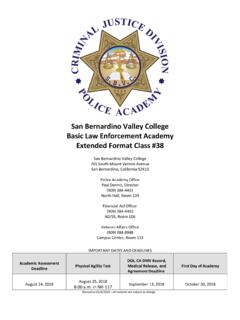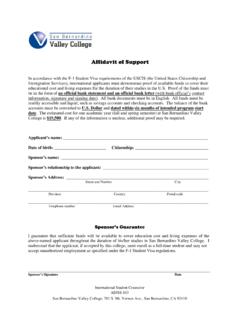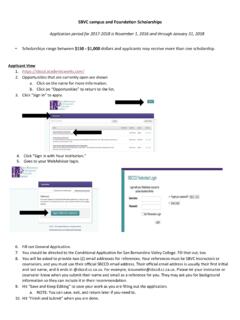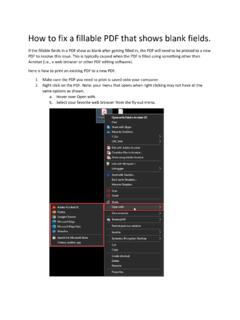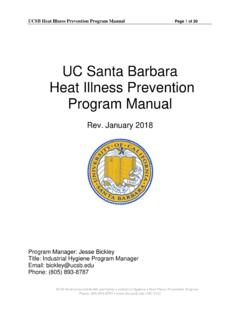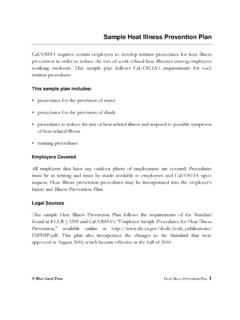Transcription of HEAT ILLNESS PREVENTION PROGRAM
1 heat ILLNESS PREVENTION PROGRAM I. Scope The SBVC heat ILLNESS PREVENTION Plan (HIPP) is intended to provide SBVC employees with a safe working environment and control the occurrence of heat related ILLNESS . The HIPP applies to: all outdoor areas of the campus where employees can be assigned to work, and where environmental conditions cannot be mitigated by active cooling methods; indoor or covered facilities where the air temperature meets or exceeds 100 degrees Fahrenheit; and, emergency response personnel and any college employee who is required to wear and perform work in full-body personal protective suits, regardless of interior or exterior ambient temperatures. Grounds Maintenance Automotive Tech programs Maintenance & Operations Welding Custodial Maintenance Refrigeration Tech programs Art Department Physical Education Child Development Center Athletics Campus Police & Police Academy Food Services II.
2 PROGRAM Responsibilities The Vice President of Administrative Services is the designated heat ILLNESS PREVENTION PROGRAM Administrator and is responsible for the implementation and annual evaluation of the PROGRAM . The Administrator will: coordinate formal PROGRAM reviews and revisions with the College s Facilities and Safety Committee (FASC); distribute the HIPP to the campus community, including administrators, managers, supervisors, and academic deans; facilitate initial employee training for the appropriate college employees, managers and supervisors covered by this Plan; Last revision January 2010 1 and, maintain copies of employee training records and ensure that copies are also maintained by the respective work area supervisor. Managers, supervisors, and academic deans will: ensure that employee work assignments, both indoors and outdoors, are evaluated and the components of this HIPP are implemented when the established temperature/humidity thresholds are met or exceeded; make active and/or passive (shading, etc.)
3 Cooling equipment available to employees that may require its use; ensure that initial and periodic training is provided to employees under their supervision and that the training is consistent with the requirements put forth in this HIPP; maintain copies of employee training records and forward file copies to the office of the Vice President of Administrative Services; and, observing employees for signs of heat -related ILLNESS and taking quick action to ensure immediate assistance is provided when necessary. Employees are responsible for: understanding and complying with the requirements of this HIPP; understanding the responsibilities of both the college and its employees for maintaining compliance with this PROGRAM ; immediately reporting any observed unsafe working conditions to their supervisor and take any necessary steps to mitigate personal risk factors that may exist prior to beginning work in a regulated high temperature or humidity environment; Failure for any SBVC employee to observe and comply with the provisions of this safety PROGRAM may result in progressive disciplinary action as outlined by the California Educational Code.
4 III. Definitions Acclimatization - The temporary adaptation of the body to work in the heat that occurs gradually when a person is exposed to it. Acclimatization peaks in most people within four to fourteen days of regular work for at least two hours per day in the heat . heat ILLNESS - A serious medical condition resulting from the body's inability to cope with a particular heat load, and includes heat cramps, heat exhaustion, heat syncope and heat stroke. Last revision January 2010 2 Environmental risk factors for heat ILLNESS - Working conditions that create the possibility that heat ILLNESS could occur, including air temperature, relative humidity, radiant heat from the sun and other sources, conductive heat sources such as the ground, air movement, workload severity and duration, protective clothing and personal protective equipment worn by employees. Personal risk factors for heat ILLNESS - Factors such as an individual's age, degree of acclimatization, health, water consumption, alcohol consumption, caffeine consumption, and use of prescription medications that affects the body's water retention or other physiological responses to heat .
5 Preventative recovery period - A period of time, at least five minutes, used to recover from the heat in order to prevent further heat ILLNESS . Shade - Blockage of direct sunlight. Canopies, umbrellas and other temporary structures or devices may be used to provide shade. One indicator that blockage is sufficient is when objects do not cast a shadow in the area of blocked sunlight. Shade is not adequate when heat in the area of shade defeats the purpose of shade, which is to allow the body to cool. For example, a car sitting in the sun does not provide acceptable shade to a person inside it, unless the car is running with air conditioning. IV. PROGRAM Components The following elements of the college s PROGRAM for heat ILLNESS PREVENTION provide specific information for departments and supervisors complying with the PROGRAM : Provision of Water Whenever environmental risk factors for heat ILLNESS exist, supervisors are responsible to ensure that clean, fresh, and cool potable water is readily available to employees.
6 Where unlimited drinking water is not immediately available from a plumbed system, supervisors must provide enough water for every employee to be able to drink one quart of water per hour for the entire shift (at least 2 gallons per employee for an 8-hour shift). Smaller quantities of water may be provided at the beginning of the shift if there are effective procedures for replenishing the water supply during the shift as needed. It is the manager s responsibility to ensure water supplies are replenished as necessary. The Cal/OSHA standard requires not only that water be provided, but that supervisors encourage employees to drink frequently. Employees must Last revision January 2010 3 be understand that thirst is not an effective indicator of a persons need for water and it is recommended that individuals drink one quart of water, or four 8-ounce cups, per hour when working in hot environments. Departments shall take one or more of the following steps to ensure employees have access to drinking water: 1.
7 Provide access to drinking fountains 2. Supply water cooler/dispenser and single service cups 3. Supply sealed one time use water containers Drinking water and water dispensers shall meet the following requirements: All sources of drinking water shall be maintained in a potable and sanitary condition Drinking water must always be kept cool. When temperatures exceed 90 F it is recommended that ice be provided to keep the water cool. Potable drinking water dispensers used to provide water to more than one person shall be equipped with a spigot or faucet Any container used to store or dispense drinking water shall be clearly marked as to the nature of its contents and shall not be used for any other purpose Dipping or pouring drinking water from containers, such as barrels, pails or tanks, is prohibited regardless of whether or not the containers are fitted with covers The use of shared cups, glasses or other vessels for drinking purposes is prohibited Non-potable water shall not be used for drinking, showering, washing, etc.
8 Outlets for non-potable water shall be posted in a manner understandable to all employees that the water is unsafe for drinking Access to Shade Supervisors are responsible to ensure that employees have access to a shaded area. Shaded areas should be large enough to accommodate 25 percent of the employees on a shift and allow employees to sit in the shade without touching each other. The nearest shaded area must be as close as practicable. Usually this will mean that shade must be reachable within a 2 1/2 minute walk, but in no case more than 1/4-mile or a five minute walk away, whichever is shorter. Canopies, umbrellas or other temporary structures may be used to provide shade, provided they block direct sunlight. Trees and dense vines can Last revision January 2010 4 provide shade if the canopy of the trees is sufficiently dense to provide substantially complete blockage of direct sunlight.
9 Areas shaded by artificial or mechanical means, such as by a pop-up canopy as opposed to a tree, must provide means for employees to avoid contact with bare soil. The interior of a vehicle may be used to provide shade if the vehicle is air-conditioned and the air conditioner is operating. If the National Weather Service, as of 5 the previous day, forecasts the temperature to be over 85 F, shade structures must be available at the beginning of the shift and present throughout the day. Regardless of predicted temperatures, supervisors must always have the capability to provide shade promptly if it is requested by an employee. If the temperature exceeds 90 F, shade must actually be present regardless of the previous day's predicted temperature high. Acclimatization Supervisors are required to acclimatize employees and allow time to adapt when temperatures rise suddenly and employee risks for heat ILLNESS increase. Acclimatization is required for new employees, employees working at temperatures to which they haven't been exposed for several weeks or longer, or employees assigned to new jobs in hot environments.
10 Generally, about four to fourteen days of daily heat exposure is needed for acclimatization. heat acclimatization requires a minimum daily heat exposure of about two hours of work. Gradually increase the length of work each day until an appropriate schedule adapted to the required activity level for the work environment is achieved. This will allow the employee to acclimate to conditions of heat while reducing the risk of heat ILLNESS . It should be noted that new employees are among those most at risk of suffering the consequences of inadequate acclimatization. Supervisors with new employees should be extra-vigilant during the acclimatization period, and respond immediately to signs and symptoms of possible heat ILLNESS . Preventive Recovery Periods The purpose of the recovery period is PREVENTION of heat ILLNESS . The supervisor is required to provide access to shade for employees who believe they need a preventive recovery period from the effects of heat and for any who exhibit indications of heat ILLNESS .
